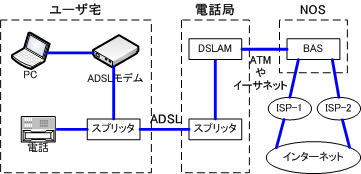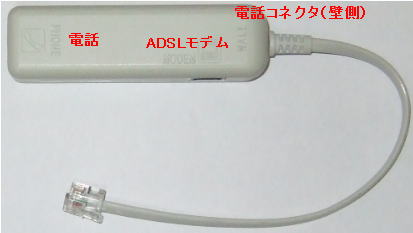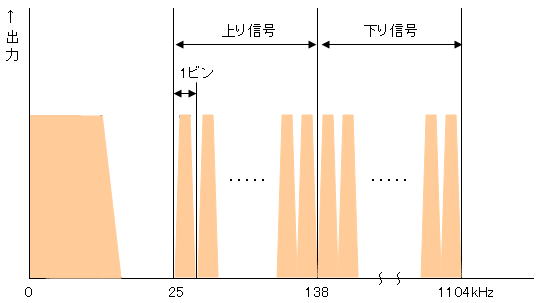ADSLとは
ADSLとは、Asymmetric Digital SubscriberLine(非対称デジタル加入者線)の略で、一般の電話線(メタリックケーブル)を利用して高速なデータ通信を行う技術です。
電話の音声を伝えるのに使用する周波数帯は、4kHz未満の低周波です。電話線には、それ以上の高周波を伝送する能力があり、ADSLでは音声には使わない高周波数帯を使って通信を行ないます。
ADSLは、xDSL技術の一種です。xDSLとは、音声よりも高い周波数帯を使うことで、高速なデータ転送を行う技術のことで、データ転送の方式の違いでADS、SDSL、HDSL、VDSLなどの種類があります。
ADSLは、非対称デジタル加入者線の名前の通り、上りと下りの速度が違うという特徴を持っています。上りよりも下りの方が、伝送能力が高くなっています。
これは、一般的なインターネット利用を行った場合、アップロードよりもダウンロードの方が、遥かに多く利用するからそういう仕様になっています。
ブロードバンド接続には、ADSLの他に、FTTHやケーブルTVなどもありますが、FTTHやケーブルTVの場合、屋内への配線工事と専用のモデムの設置が必要なため、ADSLより導入がやや困難であったり、費用が高くつきます。
ADSLは、電話線をそのまま利用でき、配線工事も簡単で、利用サービス料も安価なため、導入が手軽であるというメリットがあります。
そのため、ADSLは、手軽に利用できるブロードバンド接続として、広く普及しています。また、FTTHやケーブルTVと比べると速度が遅いのが難点でしたが、高速なADSLが登場しており、下りが50Mbpsのスピードが出せるものや、上りのスピードも従来のADSLと比べて遥かに速いスピードが出せるものもあります。
リーズナブルな値段で、高速ブロードバンド環境を手に入れることができるのが、ADSLの最大のメリットです。
ADSLの仕組み
ADSLの接続構成例は、下図の通りです。

スプリッタ
ADSLでは、電話線を使用します。、電話線上には電話通話用の低周波信号と、インターネット通信用の高周波信号の両方が存在ます。そこで、電話で使う信号と、ADSLで使う信号とを分離する必要があります。その分離を行うための装置がスプリッタです。
※スプリッタを用いなくてもよいケースもあります。マンションやアパートなどの集合住宅では電話回線をまとめる装置にスプリッタが設置されている場合があります。
ADSLモデム
ADSLモデムは、コンピュータのディジタル信号をアナログ信号に変調したり、電話局側のアナログ信号をコンピュータのディジタル信号に復調します。ADSLモデムとスプリッタとの接続には電話線を使います。電話線が長くなるとノイズや通信スピードの減速の原因となります。
DSLAM(DSL Access Multiplexer)とBAS(Broadband Access Server)
電話局内には、xDSLを束ねるDSLAMが設置されています。インターネットへはBASを介して接続します。
ADSLモデムとBASは、PPPをカプセル化したPPPoEやPPPoAを用いて通信を行います。そうすることで、個々のユーザを個別に識別し、IPアドレスを割り当てたり、契約しているISPに振り分けることを可能にしています。
フレッツADSLでは、ユーザ認証に、メールアドレス風の表記を使って接続先のプロバイダとプロバイダのユーザ名を一括して処理しています。
スプリッタ
ADSLでは、電話線を使用します。、電話線上には電話通話用の低周波信号と、インターネット通信用の高周波信号の両方が存在ます。
電話の音声の伝送には、4kHz未満の低周波数帯を利用し、データ通信に4kHz以上の音声には使わない高周波数帯を使って通信を行ないます。電話で使う信号と、ADSLで使う信号とを分離する必要があります。その分離を行うための装置がスプリッタです。

スプリッタのコネクタは、全てRJ11で、電話線を接続します。スプリッタのADSLモデム側とADSLモデムを接続します。また、スプリッタの電話側と電話を接続します。電話線が長くなるとノイズや通信スピードの減速の原因となるため、取り付けには注意が必要です。
従来のデータ通信では電話回線に直接モデムを接続し、通話とデータ通信が回線を共有することができませんでしたが、ADSLでは、使用する周波数帯を分離することにより、通話中でもデータ通信を行うことが可能となっています。
ADSL(DMT方)
ADSLは、国内では、当初G.992.2(G.lite)規格による1.5Mbpsサービスが主流でしたが、Yahoo! BBがG.992.1(G.dmt)規格による8Mbpsサービスを2001年8月に開始したことで、他社も続々と8Mbpsサービスを開始し、ADSLの高速化競争が始まり、今では50Mbpsのサービスまで登場しています。
ここでは、G.992.1(G.dmt)に焦点を当てて説明して行きます。G.dmtでは、4MHzごとに使用する帯域をビンという単位に分割し、ビン単位でデータを伝送します。

1つのビンがノイズの影響を受けても、残りのビンで伝送することができるのでノイズに強い特徴があります。
上りには、26kHz~138kHzの周波数帯を用い、最大伝送速度1.1Mbpsで、下りには138kHz~1,104kHzを用いて、最大伝送速度8Mbpsで通信を行うことができます。
ADSLでは、サービスにより伝送方式の規格や付帯規格が異なるので専用のADSLモデムが必要です。ADSLモデムを使用する場合には、注意が必要です。
ADSLの欠点
ベストエフォート型サービス
ADSLでは、1.5Mbps、8Mbps、12Mbps、24Mbps、40Mbps、47Mbps、50Mbpsなど最大通信速度を選択してサービスを契約できますが、その最大通信速度は、必ず契約した最大通信速度が出せることを補償するものではないと言うことです。
最大通信速度は、あくまでも理論値です。ADSLは、ノイズの影響や信号の減衰などが要因で、満足する通信速度が得られない可能性があります。
ノイズに弱い
ADSLは、比較的ノイズに弱く、ISDNから受ける漏話やAMラジオなどのノイズの影響を受けて、信号が減衰する場合があります。特にAnnexAの仕様のADSLでは、極端にISDNの影響を受けます。また、屋内の電話線もノイズの影響を受ける場合があります。
収容局からの距離に比例して速度が低下する
電話局回線収容局から距離が離れれば、離れるほど、それに比例して通信速度が低下します。それは、高周波数帯になるほど信号の減衰が大きいからです。
せっかく、高速な50MbpsなどのADSLサービスの契約をしていたとしても、収容局からの距離が離れていれば、低い速度でしか接続できないことになります。ADSLを契約する際には、事前に電話局収容局からの距離をあらかじめ調べておく必要があります。
上りの通信速度が遅い
ADSLでは、上りと下りの通信速度が異なります。下りの通信速度を優先させる為、下りの方が、上りの通信速度よりも遥かに速くなっています。
つまり、上りの通信速度が遅いので、ホームページを頻繁にアップロードするとか、動画などの大容量のファイルをアップロードするといった用途が多い方は、上りと下りが同じ通信速度であるFTTH(光ファイバ)の方が良いかもしれません。
別途工事が必要な場合がある
経路の途中が光ファイバーになっている場合は、ADSLの利用ができません。別途工事が必要になります。ディジタル回線(ISDN)を利用している場合、アナログ回線に戻す必要があるため、別途、工事費が必要になります。その際、電話番号が変わる可能性もあります。
